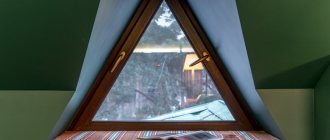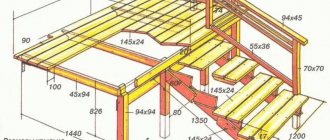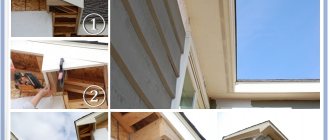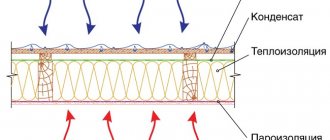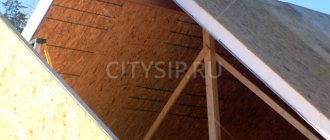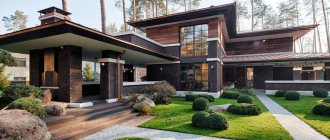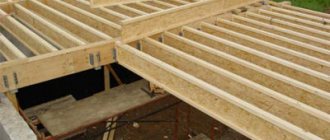It would seem that in our age of abundance of building materials, it is not difficult to choose a waterproofing coating that meets the high demands of modern residential construction. Ondulin, flexible tiles, roofing felt, and roofing metal serve as excellent protection against the penetration of cold air, rain or snow, but they are not always environmentally friendly.
On the other hand, there are traditional methods of covering residential buildings that do not harm human health, for example, reed roofing. In this article we will tell you what plant material can be used to build a roof, how to prepare and lay it for maximum waterproofing.
Reed roofing: main features
Let’s be clear right away: reed roofs and thatched roofs are practically the same thing. According to the properties of the material, according to the installation technology, according to the rules of operation and repair. The only difference is the place of growth. Reed is a coastal aquatic plant, and straw is cereal stems. Treated reed stems, dried and prepared for laying, are often called straw.
For a long time, reed roofs were undeservedly forgotten. And completely in vain. Although in those distant times there were no such straw processing technologies as there are today. Therefore, roofs made of untreated reeds (straw) looked unpresentable and were considered the lot of the poor.
A lot has changed now. The most successful people cover their mansions with straw or reeds and do not experience any inconvenience.
- This is a non-standard approach to architecture. The skillfully laid thatched roof sets the building apart from others, and at the same time complies with established roofing standards.
A reed roof will last 50–60 years if the rules for the procurement of raw materials and installation conditions are followed.
- Environmentally friendly natural material was used, which wealthy people value very much and are willing to pay a lot of money for.
- But the most valuable thing is the unusual aura that a thatched roof creates. A lot of things are mixed here - both the legends of deep antiquity and the marvelous fairy-tale design created thanks to the long flexible stems of reeds. And properties - the ability to maintain optimal temperature inside buildings regardless of the time of year.
In summer, under a reed roof, the house will always be cool, and warm in winter.
A thatched roof significantly reduces the cost of air conditioning and heating. It does not require a ventilation or drainage system. Nevertheless, reed roofing is still expensive, which is why it belongs to the elite category. A custom reed roof costs about the same as installing a roof made of natural tiles, which, alas, is beyond the means of most consumers. Unless you do the harvesting of reeds (straw) yourself. But more on that later.
So, let’s summarize what is good about thatched roofing:
- it is an excellent sound, heat and water insulator;
- environmentally friendly material - the stems are cut very young, when they are no more than a year old, so they do not have time to “charge” with toxins;
- provides good natural ventilation;
- excellent dielectric, thanks to which the reed roof is protected from lightning strikes;
- improves the well-being of those living in the house - many people know about reed therapy - while some modern building materials, even the best ones, reduce the human biofield - adobe, reeds, straw, on the contrary, increase it;
- has amazing moisture resistance - growing in a humid environment, the reed has learned to resist moisture, which is why it does not allow precipitation deeper than 3 cm;
- allows you to create an original extravagant coating;
Using long flexible stems of reeds they create roofs of the most unusual shapes.
- It has an enviable longevity - reeds treated with antiseptics are resistant to mold and mildew, so a thatched roof can be pleasing to the eye for 50 years without repair.
Let us separately mention one more, one might say, rare property of reed roofing - its ability to change color over the years. Only a copper roof is endowed with this feature, which also belongs to the elite category, but is inferior to a thatch roof in some respects - it has a more complex structure, as well as more difficult and expensive installation work. The reed roof initially has a golden color, which becomes deeper and darker over the years, and after decades, takes on a greenish-brown color, merging with the landscape.
Disadvantages of reed roofing:
- reed covering is suitable for pitched roofs with a slope angle of 35° and above - technologies are now being developed that will probably allow its use for slight slopes, but this is still at the project stage;
- even after treatment with fire retardants, the possibility of fire remains;
- Thatched roofs are a favorite habitat for birds, which can cause a lot of trouble.
Although the last statement is very controversial - the reed roof is laid in a thick layer and it is unlikely that the birds have a sufficient beak to peck through it to the base. In addition, treatment with various antiseptics is more likely to repel birds than attract them. So they won’t cause much damage, but they can cause mischief. Therefore, special attention should be paid to densely laying the reed covering.
Reed roofs are very widely installed abroad. What about roofs, entire houses are already being built from straw and reeds. In Russia, reed coverings are still used little - either they don’t trust this material, or they know little about it. But since we started talking about reed roofs, it means that it’s all just a matter of time. And while many developers still have doubts, some are already enjoying such a roof and do not regret it at all.
Video: my cozy home - thatched roof
Elimination of defects
A reed roof, in addition to its advantages, also has disadvantages, which can be dealt with using different methods:
- Burns well. To protect against such a disadvantage, there are various processing technologies, including impregnation with compounds with fire-resistant properties. The material must be processed both from the outside and from the inside. The impregnation has a composition that cannot be removed by various types of sediment.
- For obvious reasons, it is a favorite place for birds. The stems are used by birds as an excellent building material for arranging nests. To prevent birds from dragging stems from the roof, they need to be well compacted, and protruding ends should be excluded from the planned and dense roof.
A mansard-type reed roof, thanks to the high performance qualities of the material, can last a long time without creating problems. The main thing during installation is to comply with all technical conditions and to prepare the base structure from the lathing well.
Note! There is a misconception at the everyday level that reeds are a cozy place for rodents to live. In fact, they prefer old tiles, and stems treated with fire retardants do not seem to be a possible hiding place for them.
DIY reed roof
Only high-quality raw materials can guarantee the durability of a reed roof, as well as a roof made of any other covering material. About 30 species of reed grow in Russia, but not all of them are suitable as roofing. The best roofing reeds are obtained from those plants that live on peaty-boggy soils, covered with a layer of fresh water all year round.
Before harvesting, a section of reeds must be mowed, or even better, burned, which will create favorable conditions for a high harvest in the future. Harvesting begins immediately after the first frost. They mow down the reeds above the water at this time of year. They use agricultural machinery, which greatly simplifies the collection of reeds.
But if you make the harvest for yourself, you can mow it manually using a cutting tool - a tarpan. This is a rather complex and time-consuming process. One person can mow and tie about 60 sheaves per day. How many such bundles are required depends on the area of the roof - residential buildings are covered in 3 layers, gazebos, verandas, etc., in two layers. Approximately 8–10 bunches (sheaves) are used for each meter of base.
The reed for the roof should be:
- not older than 1 year;
- have a stem 1.5–2 m long and 5–8 mm thick;
- without any external defects (stains, damage) and golden color.
Plants that do not meet these parameters should not be used to cover roofs.
The cut reeds are tied into small bundles and left to dry.
The reeds are tied into sheaves and left to dry for several months.
When the moisture content of the stems does not exceed 18%, the sheaves are collected into piles with the tassels facing upward and dried for several months. Then the panicles are cut off, leaves and other debris are removed, treated with special compounds and stacks are formed for subsequent laying.
Video: ancient secrets of making roofs
Photo
Brick house covered with reeds
Dovecote
Wood storage
Gazebo made of natural materials
The bathhouse is covered with reeds Last edition: 05/11/2017 Author: Vrubel Yaroslav Grigorievich
Reed roof installation
The reed roof has a number of characteristic features:
- the rafter system for such a roof is usually made of wooden boards;
- lay sheaves on solid OSB or chipboard boards laid on top of a sheathing made of square timber 50 x 50 mm (or rectangular 40 x 60 mm) in increments of 30–35 cm;
- lay the straw on a metal mesh covering the ridge and secure it with wire;
- install clamping strips and clamping strips, as well as stiffening ribs under OSB (chipboard) boards;
- The ridge is made from tiles, but if desired, it is also made from straw sheaves.
The reeds are laid on a perfectly flat surface. OSB or chipboard boards are used for this.
Although there is nothing complicated about the roofing pie of a reed roof, and no special equipment is required for installation work, nevertheless, beginners should first try their hand at a small object. To acquire skills and subsequently competently install a reed roof of a residential building.
Video: laying an eco-roof made of reeds
Laying technology
Laying reeds on the roof begins with the installation of sheathing. Sheathing slats, made of timber 40x60 or 50x50 mm thick, are laid across the rafters in increments of 300 mm. After this, you can proceed to directly laying the plant material. The installation process is as follows:
- Screws are screwed into the sheathing or nails are driven into which the galvanized wire or hemp rope necessary to hold the cattail sheaves will be attached.
- Laying begins from the lower edge of the roof overhang; the lower tier of cattails should extend 50 cm beyond the edge of the roof overhang.
- The first tier of plant material is fixed from a stepladder, scaffolding or high ladder, and subsequent installation is carried out by moving the lathing, which must support the weight of a person.
- Cattail sheaves are fixed tightly to each other on a wire until a uniform layer is obtained that will not allow moisture to pass through.
- After laying the sheaves on the slopes, they proceed to the design of the ridge. To do this, shorter stems are used, which are laid along the ridge connection and then pressed with a ridge profile.
- After the installation process is completed, the sheaves are tapped and leveled so that the roof acquires a beautiful, aesthetic appearance.
Remember that it is more effective to treat the finished roof with a fire retardant compound, rather than the raw materials. When treated with a fire retardant, the composition penetrates to a depth of 5 cm. During operation, the substance protecting against fire is washed off by rain, so the treatment should be repeated after 3-5 years to prevent fire due to a lightning strike or a spark from a heating device.
Reed laying scheme
Laying
Leveling the reeds
Features of operation
In order for a reed roof to serve for many years without losing its beautiful appearance and rare qualities, it needs proper care, which consists of the following:
- Inspect the condition of the roofing 2 times a year and, if damaged stems are found, replace them immediately.
- Renew the top roofing layer after 10–15 years and clean the reeds over the entire area.
- Do not go onto the roof unless necessary.
- Treat with fire retardants every 2–3 years, since due to rain, the initial impregnation gradually loses its properties.
The operating rules are simple, but replacing the top layer, of course, will require financial costs. But a reed roof, if properly cared for, will last for decades and be inherited.
As for the monetary costs of maintaining a reed roof, then again everything is comparable. Any roof needs care and timely repairs. Moreover, if you made the reed roof yourself, starting from preparing the material and ending with its installation, then replacing the top layers will not cost you a penny.
Reed roof repair
With proper care of the reed roof and its strict arrangement, repairs, as a rule, will not be needed for a long time. Perhaps only eliminating current problems in a small area due to the use of low-quality or improperly prepared raw materials. This is determined by visual periodic inspection. Rotten stems are replaced all the way down to the base, otherwise there is a high probability of bacteria spreading deeper and wider, and then there will be little use from surface repairs.
The reeds are periodically compacted. This is painstaking work, but it is done rarely and gives the roof the beauty of fresh greenery. Often, shortened stems are used near junctions, roof windows, along valleys and ridge ridges, and if the coating technology is violated, such places become problematic over time. Experienced roofers suggest initially making such units in a more practical version. Moreover, reed is a universal material that will fit perfectly into any cladding configuration.
The ridge ridge, roof windows, junctions and eaves lining are made of other building materials; the reed roof only benefited from this - it became more clear and expressive
Video: installation of reed roofing - ridge installation
It is better to carry out repair work in early summer, when the damaged areas are clearly visible and repairable.
Conditions of stay for prisoners in the Alger camp
Women had to sleep on three-tier bunks. Those who did not have enough seats sat on the wooden floor. Prisoners were forbidden to receive letters, parcels and other things from outside the prison. Visits were not allowed either.
The territory of "Alger" was fenced with three rows of barbed wire. Every day women were forced out to work. Moreover, only a few worked in their specialty. Agricultural and construction work were the main ones. Children, the sick and elderly women were sent to embroidery and sewing workshops.
Local residents fed the camp prisoners. Kurt is a cheese made according to a national recipe. It looked like stones. Therefore, the guards had no idea about the “delicacy” being planted.
Reviews
I was looking for a way to save on hydro, steam and thermal insulation when building a roof. I came across information that coverings such as straw, reeds and reeds completely eliminate this issue. An interesting solution, I didn’t even initially imagine that I would take a closer look at this option. I myself live in Petrozavodsk, I have never seen such roofs on anyone yet.
Michael
https://trostnik.su/gostbook.php
Vapor barrier is not needed, the reed does not rot (note that it remains in water even after the death of the plant). Since it does not rot, there is no place for microorganisms to live there. Fire impregnation is needed if there is a danger that the fire pit will fall on the roof; if not, then you can do without it. Insulation is also not needed - the thickness of the coating allows you to do without it.
hilyaki
https://www.forumhouse.ru/threads/94039/
I want to share my experience on how to make thatched roofs. The thickness of the coating layer is determined by the slope and length of the slopes. I had the following data: length six and a half meters and angle of inclination of forty degrees. The straw was laid twenty-three centimeters thick at the ridge and twenty-five centimeters thick at the base.
Victor S
https://trostnik.su/gostbook.php&page=4
A reed roof is a good thing... it is advisable to burn out or cut off the first reeds, and next year there will be even ones of the same size. And thick reeds are not suitable, only thin ones are 5-6 mm, and thick ones lie heavily and are suitable for walls.
Solly267
https://www.forumhouse.ru/threads/94039/
Information for those who are concerned about the flammability of thatch and thatch roofs. The solution is very simple: between the base and top layers of a thatched roof, a fire-resistant membrane is laid, which inhibits the spread of flame, and the roofing material itself is treated with fire retardants
Andrey Dmitriev
https://trostnik.su/gostbook.php&page=4
Good day to all! From my personal experience I can say that a reed roof is a reliable roof. It’s already “worth” itself 7 years in peace. He doesn’t ask to eat or drink, just yet) All the neighbors come and admire him. If anyone is interested, I can send you a photo. By the way, the reeds are from Russia and the roof slope in my house is -40 degrees. As they explained to me, the angle of the slope is important for a reed roof.
89267667546
https://www.forumhouse.ru/threads/19292/page-4
I tell many who ask me about reed roofs that the main criteria that determine its service life are the angle of inclination and orientation of the slopes. The Dutch, and these are the gurus in reed roofing, give the following dependence of the service life on the angle of inclination of the slopes: 25 ° - up to 15 years 30 ° - from 10 to 20 years 45 ° - from 25 to 45 years 50 ° - 45 years and more Let me remind you, that the service life is calculated from construction to major repairs. If you properly maintain your roof, the period of repair can be significantly extended.
eco-structure
https://www.forumhouse.ru/threads/19292/page-4



